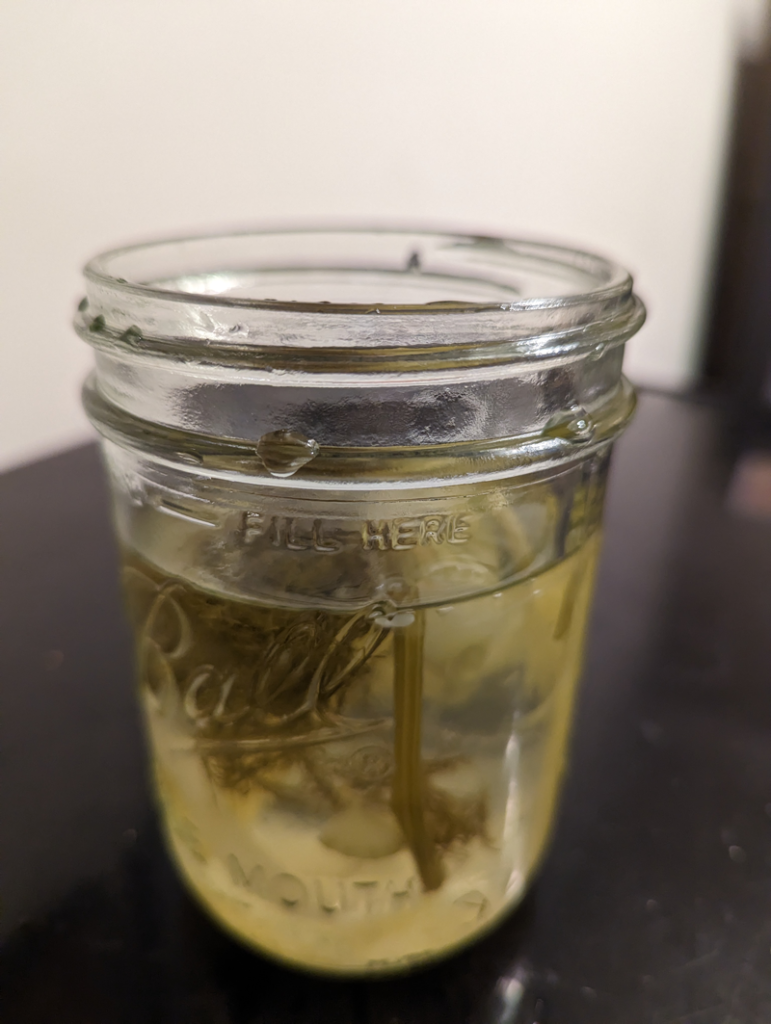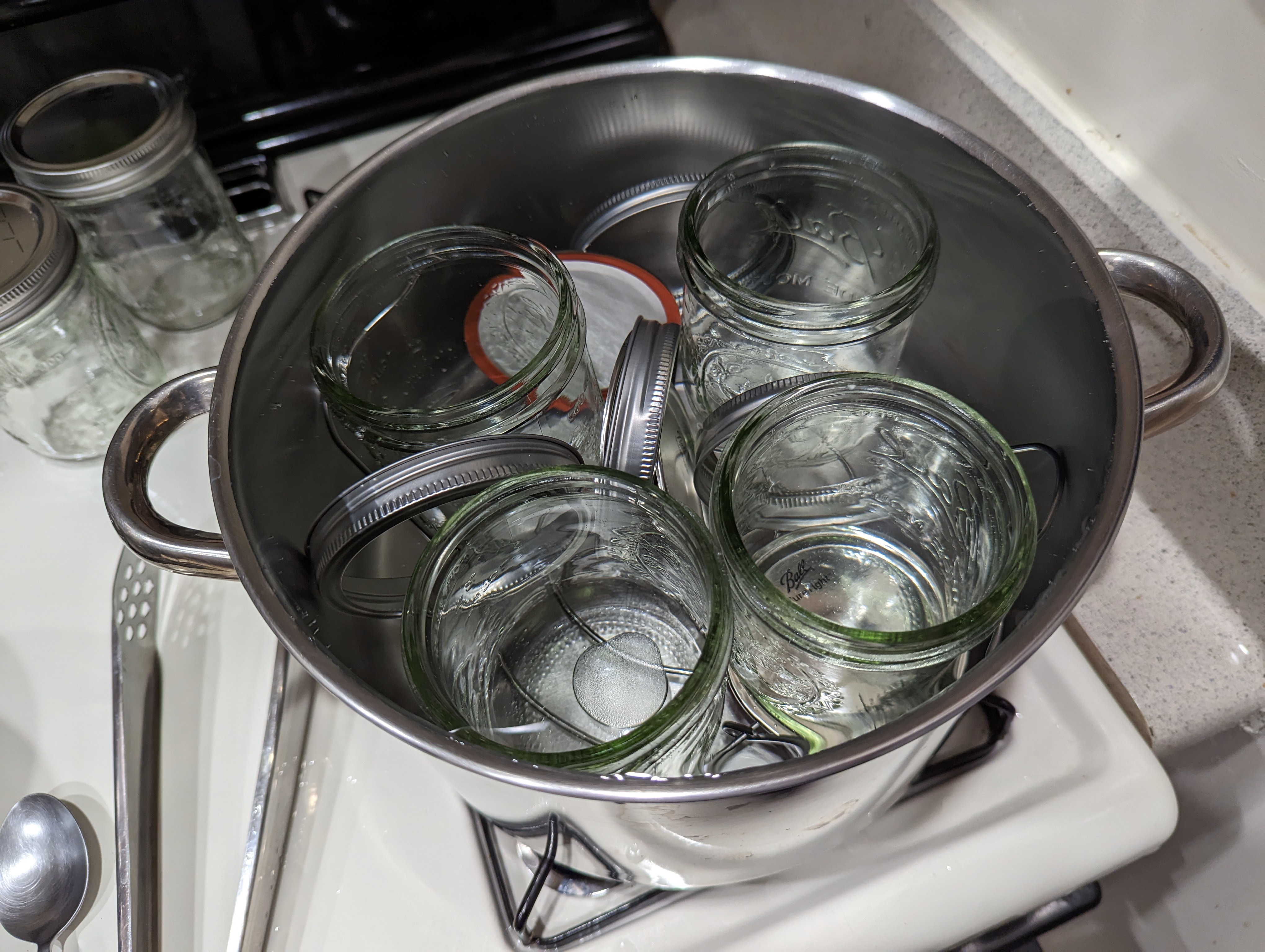This is the tenth post in my family culinary history series. To start from the beginning, please see my Connecting with my Ancestors through their Recipes post.

Delicious Pickles
Wash and cut 1 inch long chunks to fill 4 quart jars. To each jar add 3 or 4 onion slices, 2 celery stalks and 2 bunches of dill. Dissolve 4 cups sugar, ½ cup salt 1 quart vinegar and 1 quart water.
Heat. Pour while hot over cucumbers. Good to eat after 1 month.
I love pickles and have been fascinated by slow food preparation styles such as pickling and fermentation, so I had been looking forward to making this recipe for a long time. Additionally, this recipe seemed like a something I could easily whip together while taking a break from some of Irene’s less… shelf-stable recipes. Oh, how naive I was…
Surprise Canning
Reading through Irene’s recipe, it seems so simple. Just put ingredients into a jar, set aside for a month, and… poof… you have pickles. Easy.
I thought that I could just leave the jars on the countertop while I caused other mischief in the kitchen, but as with every single one of these recipes it would not be as simple as it seemed at first glance.

After some reflection and research as well as conversations with my mother, I realized that just stuffing some jars and leaving them to sit might not be the safest plan.
To really make these pickles, I was going to have to can them… Something I had never done before. Well, it’s not like I had anything else planned for my weekend…
Canning Crash Course
Using a how-to guide printed on the back of a Ball canning jar package, my mother on speed dial, and a can-do attitude that oscillated between hubris and fatalism, I began my canning adventure.


I did not quite have the right equipment to water can, but I figured I could hack my way through the process using items from around the kitchen. I used a stock pot for the water bath and a part of my InstaPot for the rack to rest the jars on in the water bath. And despite my mom’s advice, I used wide mouthed jars because I already had them.
The jars did not really fit in the pot and I had doubts about how I would be able to get the jars out of the pot, but what’s the worst that could happen?
Enough to Fill a Jar
However, before we get into all of that, first I had to fill the jars.
Irene’s recipe was not so forthcoming with the exact number of cucumbers I would need, but a respectable seeming recipe by Love and Lemons recommended 48 to 56 Persian cucumbers or 32 to 40 pickling cucumbers for a gallon jar.

While at the store, I had some cold feet at the number of cucumbers filling my bag and erred on the side of only about 30 or so Persian cucumbers.
And when I first started filling the jars even this seemed like way too many. I ended up only using about half the cucumbers that I bought! I could not figure out why the Love and Lemons recipe could recommend so many!
However, after I finished canning, I realized I had not done as good a job stuffing the jars as I thought and could have easily fit all the cucumbers into the jars if I had done a better job stuffing them.


Making a Mess
Now that I had my ingredients ready and my canning station set-up, it was time for the step that seems to come with every one of the recipes I make, namely that of making a mess. I think I made more of a mess making these pickles than I did when I tried to make Irene’s doughnut recipes.
Remember when I asked what was the worst that could happen earlier? Well, this is the step in the process when we answer that question.
Sterilizing Jars
Pro tip, when a canning guide recommends that you have a pot deep enough to cover your canning jars with a inch or two of water, there’s probably a reason.
Not only could I only fit about half of my jars in my pot at a time (forcing me to have to do two rounds of canning), but there was barely enough room in the pot for the jars and the water together.

This meant that every time I pulled out and put in a jar, the water would overflow from the pot and spill all over my oven.
The water would then saturate my burner to the point it would not light, creating a fun game of whack-a-burner where I had to rotate the pot around the stove to find one that worked while I hoped the others dried out.
Although, the most disturbing part was probably the dripping noises that came from the back of my stove near the end. My downstairs neighbors never did complain so…
Although, I did have to have the apartment maintenance crew come and fix the stove’s pilot lights which seemed to stop working for some reason. They said that some liquid got into the gas pipes somehow. I was as clueless as they were about how that could have happened…
Filling with Brine
Another fun adventure was filling the jars with the brine as I did not have a funnel. Somehow I managed to get brining liquid all over everything in my kitchen.
This would not have been so bad if there was not so much sugar in the brine. The sugar basically created a nice thin sticky glaze on everything such that it became hard to walk across my kitchen floor at points.
After making the pickles, I spent almost as long just deglazing my kitchen.
Tasting the Result

Since the pickles had to… well, pickle, it took a long time before I was able to actually taste the results of my labors.
After over a month of waiting, I finally unsealed a jar and tasted what my great-grandmother described as “delicious.”
It is hard to say for certain what the pickles were actually supposed to taste like, so I cannot know how close my pickles measure up to Irene’s.
However, I have to say my pickles were a bit of a disappointment. They were definitely pickled, but they barely had a snap and the flavor was fairly mild and bland.
Clearly, I am no pickling master, so I am sure that a good amount of the blame for why the pickles turned out the way they did lies on my shoulders.

Although, I am also starting to wonder if the dimensions Irene and I use to grade a recipe are different. Her “good” doughnuts were rather bland and basic to me, and these “delicious” pickles were by no way gourmet.
But perhaps this makes sense. Irene’s circumstances and experiences were different from mine. Her life was largely dictated by the demands of economically feeding a large family in a nutritious and time efficient way. My life has been impacted by an age of abundance and global travel, and I have no children or serious financial constraints.
This is one of the reasons why I wanted to make my great-grandmother’s recipes. Not just to learn new recipes and culinary skills, but to learn more about her and how she saw the world. It’s my way of having a conversation with her despite her no longer being physically present.
Pictures and Video!












Updated Recipe

Irene Caron’s Delicious Pickles
25-40 pickling cucumbers (enough to fill 4 quart canning jars)*
1 large onion
8 celery stalks
8 bunches of dill
4 cups granulated sugar
½ cup salt
4 cups white vinegar
4 cups water
Wash and cut cucumbers into 1 inch long chunks, discarding ends of the cucumber.
Sterilize four quart canning jars and their corresponding lids by placing them in a pot of boiling water. The jars should sit on a rack that elevates them slightly above the bottom of the pot and should be covered by at least two inches of water. Leave the jars in the water for at least 5 minutes to ensure they are properly sterilized.
Combine vinegar, water, sugar, and salt in a saucepan. Heat over medium heat until stirring until the sugar and salt dissolve, about 1 minute.
Once the jars are sterilized, take one jar out of the water at a time with tongs and place 3 or 4 onion slices, 2 celery stalks, 2 bunches of dill, and enough cucumber slices to fill the jars. Pour vinegar mixture over the cucumbers leaving ¼ inch on the top of the jar. Making sure there is no air left in the jars between the ingredients and that all the ingredients are covered.
Wipe the rim of the jars with a cloth and then use tongs (not hands) to put a sterilized lid on the jars and seal but do not over tighten. Place the filled jars back in the boiling water for 15 minutes. Remove from water and set aside to cool to room temperature without touching. Once the lid makes a popping sound and is cooled, store the pickles in the fridge for at least a month before eating.
* Exact number depends on the size of your cucumbers and how full you fill the jars. Love and Lemons recommends 48 to 56 Persian cucumbers or 32 to 40 pickling cucumbers for a gallon or 4 quarts
Credit: Love and Lemons, Dill Pickles, Accessed 3 Jan 2023, https://www.loveandlemons.com/dill-pickles-recipe/
Next Steps: Lady Baltimore Cake

The next recipe I was planning to make is my great-grandmother’s Lady Baltimore Cake, and as an added bonus I might even pit it head-to-head with my grandmother’s version of the same cake!
Stay tuned for a post regarding my experiences making that recipe and the struggles I overcame while doing it!

I laughed till I cried reading this!